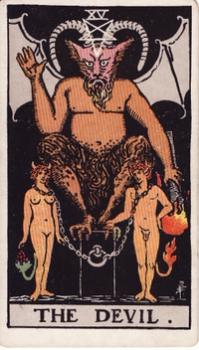
Is Tarot Evil? Dispelling the Myths
Is tarot evil?
One of the most common questions people ask when first encountering tarot is: “Is tarot evil?”
The fear is understandable. From horror movies to religious warnings, tarot is often portrayed as a sinister tool that invites dark forces. But the truth is far simpler: tarot is not evil. It is a symbolic system—a set of 78 illustrated cards designed to spark reflection, insight, and intuition.
Like a mirror, tarot reflects back what is already within you. The fear surrounding tarot comes not from the cards themselves, but from cultural misunderstanding.
A brief history of tarot: not born in darkness
Tarot did not originate as an occult tool. Instead, it began in 15th-century Italy as a card game called trionfi, which later evolved into tarocchi. These decks were lavishly illustrated and used for entertainment among nobles.
It wasn’t until the 18th century that occult writers—such as Antoine Court de Gébelin and later members of the Hermetic Order of the Golden Dawn—reframed tarot as a mystical key to spiritual wisdom.
So despite modern associations, tarot was not invented for fortune-telling, witchcraft, or dark rituals. Its evolution into a tool for spiritual reflection came centuries later.
Where did the “tarot is evil” label come from?
1. Cultural and religious bias
Certain religious traditions warn against divination. Because tarot is often mischaracterized as fortune-telling, it has been grouped with practices seen as spiritually dangerous. In reality, many tarot readers use the cards for self-reflection, psychology, and spiritual growth, not prophecy.
2. Pop culture and horror tropes
Hollywood frequently casts tarot readers as mysterious figures predicting doom. Scenes where the Death card or The Devil card appear just before tragedy reinforce fear. These dramatizations make for compelling storytelling but misrepresent the true meaning of the cards.
3. Projection of fear
Tarot imagery is filled with archetypes like Death, the Devil, and the Tower. These can feel intimidating if taken literally. But in tarot, they are symbolic:
- The Devil: Facing unhealthy attachments, not actual demons.
- Death: Transformation and new beginnings, not physical death.
- The Tower: Sudden change that clears away illusions, not punishment.
Fear arises when we project our own anxieties onto the imagery, rather than exploring its symbolic wisdom.
So what is tarot, really?
Tarot is simply a structured deck of 78 symbolic images, divided into the Major Arcana (big life lessons) and Minor Arcana (day-to-day experiences).
It is:
- A tool for self-reflection, like journaling or meditation.
- A mirror of the subconscious, helping you uncover hidden patterns.
- A language of symbols, designed to spark intuitive insight.
Tarot is not inherently spiritual or occult. It becomes meaningful through the intention of the reader.
What do practitioners say about tarot?
Respected tarot scholars consistently emphasize tarot as a tool of wisdom, not danger:
- Rachel Pollack wrote: “Tarot does not predict a fixed future. It reveals the energies at play and helps us align with our deeper truths.”
- Mary K. Greer described tarot as: “A book of wisdom disguised as a pack of cards.”
These perspectives highlight tarot as a creative, psychological, and spiritual practice, not an evil one.
What is the real “danger” of tarot?
The greatest risk with tarot is not evil—it’s misunderstanding.
- If used with fear, superstition, or dependency, tarot can fuel anxiety.
- If used wisely, it becomes a conversation with the inner self—a way to process feelings, make choices, and reflect.
Tarot does not summon forces, dark or otherwise. It reflects and amplifies your own thoughts, beliefs, and emotions.
Frequently Asked Questions: Is Tarot Evil?
1. Does tarot invite dark forces? No. Tarot cards are pieces of illustrated paper. They hold no power except the meaning you bring to them.
2. Why do some people say tarot is dangerous? Misunderstandings from religion and pop culture contribute to fear. Tarot is not dangerous when used for reflection and growth.
3. What about “scary” tarot cards like Death or The Devil? These are symbolic archetypes. Death means transformation, The Devil represents attachments, and The Tower signals sudden change. None are literal predictions of doom.
4. Can anyone use tarot safely? Yes. Tarot is safe for beginners and experienced readers alike. The only caution is to use it as a guide, not a rigid predictor of fate.
5. Is tarot fortune-telling? Some readers use it that way, but most modern practitioners see tarot as a tool for intuition and self-reflection, not fixed prophecy.
Final Thoughts: Is Tarot Evil?
The short answer: No, tarot is not evil. It is a deck of symbolic images that becomes meaningful through your interpretation.
The longer answer: tarot is a centuries-old tradition of art, symbolism, and reflection. Misunderstandings from religion, pop culture, and fear have painted it as sinister. But in truth, tarot is a neutral tool—one that can guide you toward clarity, empowerment, and personal growth.
Tarot is not about summoning darkness. It is about finding light within yourself.
Related Articles
Your First Tarot Deck Must Be a Gift: Fact or Fiction?
Debunking the myth that your first tarot deck must be a gift—why it’s a superstition, what tarot experts say, and how intention and connection truly matter.
The Ultimate Guide to Daily Tarot Pulls
Discover how daily tarot pulls help you build intuition, gain self-awareness, and learn tarot card meanings. Step-by-step guide, journaling tips, and FAQs.
You Must Be Psychic to Read Tarot: Truth or Total Myth?
Think you must be psychic to read tarot? Total myth. Discover why tarot is really about intuition, self-reflection, and personal growth — and how anyone can learn.